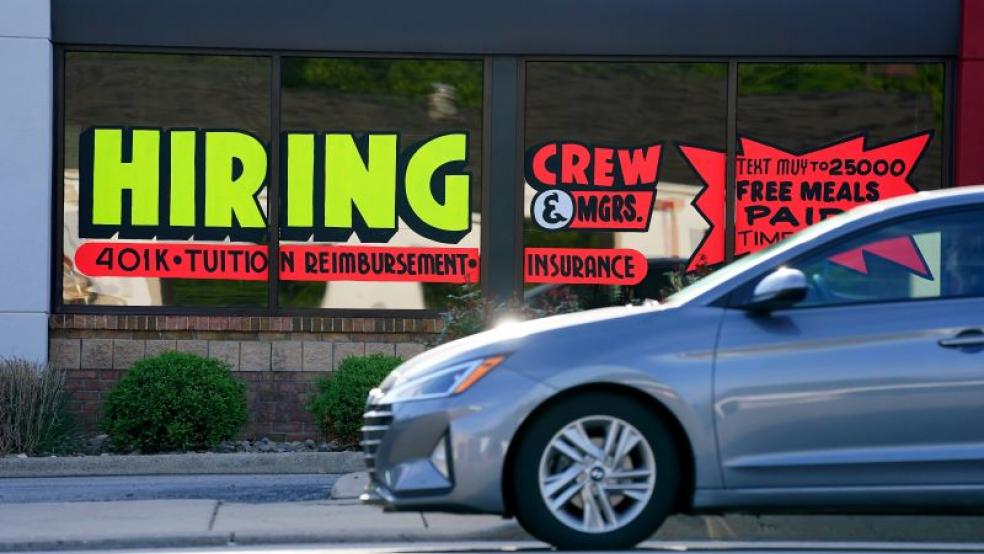Employers posted more job openings in September than expected, according to Labor Department data released Tuesday, signaling that the labor market is still quite robust as the Federal Open Market Committee meets to determine the size of the central bank’s next interest rate hike.
Analysts had expected to see another monthly decrease in job openings, continuing the trend from August, but instead, employers posted 437,000 new positions in September, increasing the number of available positions to 10.7 million. Job openings in the health care industry rose to a record high, as did the number of positions posted by major corporations.
“The surprise pickup in vacancies highlights unrelenting demand for workers despite mounting economic headwinds,” Bloomberg’s Reade Pickert says. “The persistent imbalance between labor supply and demand continues to underpin robust wage growth, adding to widespread price pressures.”
Still, despite the topline jobs number, the report provides some evidence that the Fed’s anti-inflationary tightening campaign is starting to work, as the number of new hires and job quitters moved lower. “Make no mistake: the labor market is cooling,” said Julia Pollak, chief economist at ZipRecruiter. “The job openings figure can be volatile, but the less volatile number of hires fell from 6.3 million to 6.1 million, and the number of quits slid from 4.2 million to 4.1 million.” Pollak also noted that job openings in finance and insurance have fallen for two straight months, with high interest rates “clearly taking a toll on hiring in the sector.”
The Fed mulls its next move: As it continues to wage its war on inflation, the FOMC is expected to announce a fourth consecutive 75 basis-point increase in its benchmark interest rate when it concludes its November meeting on Wednesday, raising its target rate to between 3.75% and 4%, and nothing in the latest jobs data suggests it will hesitate to do so. The bigger issue is what comes next.
Some analysts said the September report makes it more likely that the Fed will continue to push hard on rates into next year. “The JOLTS [Job Openings and Labor Turnover Summary] data this morning implies a labor market that remains tight & got a little tighter in September,” wrote Joseph Brusuelas, chief economist at the consulting firm RSM. “It also means that the Fed needs to follow through on that 75bps hike on Wed and I think will need to lift the policy rate to a range between 5-5.2% at a minimum.”
But others have argued that the Fed will pivot to a less aggressive stance at the final FOMC meeting of the year in December, with expectations of a 50-point rate increase followed by a pause as Fed officials wait to see how their tightening campaign is playing out. Ian Shepherdson, chief economist at Pantheon Macroeconomics, said in a note Monday that he expects the December rate hike to be the Fed’s last. “We see enough straws in the wind now to think that the economy is at a real inflexion point,” he wrote, citing declining home sales, slowing wage growth and lower levels of corporate investment.
The September jobs data, however, tempered expectations for a Fed pivot, with the odds of a larger rate hike in December rising to slightly better than even in financial markets Tuesday. “The good news of more job openings for everyone will be bad news for everyone if Fed officials become convinced they need to push interest rates even higher and faster than before,” said Christopher Rupkey, chief economist at FWDBONDS in New York.
A plea to slow down: Worried that the Fed will push so hard on rates that it causes a recession, a group of Democratic lawmakers sent a letter to Fed chair Jay Powell this week expressing concern about the central bank’s plans.
The authors – who include Sens. Elizabeth Warren (D-MA), Sheldon Whitehouse (D-RI), Jeff Merkley (D-OR) and Bernie Sanders (I-VT), as well as Reps. Katie Porter (D-CA), Stephen Lynch (D-MA), Rashida Tlaib (D-MI) and Jamaal Bowman (D-NY) – write that the Fed’s warning that it will act “aggressively” and that people should expect to feel “pain” in the coming months as a result of the bank’s tightening campaign “reflect an apparent disregard for the livelihoods of millions of working Americans, and we are deeply concerned that your interest rate hikes risk slowing the economy to a crawl while failing to slow rising prices that continue to harm families.”
But it’s not at all clear that lawmakers have any leverage with the Fed when it comes to interest rate policy, no matter what the cost of that policy may be to ordinary Americans. At the same time, there are plenty of inflation hawks pushing the Fed to press ahead. Former Treasury Secretary Larry Summers said Tuesday that those pushing for the Fed to pause its tightening campaign are “badly misguided.”
“History suggests that once generated, high inflation is very hard to stop,” Summers warned. “The vast majority of efforts to stop inflation have failed in industrial countries. … If the @federalreserve doesn’t carry through on the market’s current expectation that rates will approach 5 percent, markets and others will see it as an easing.”
In an interview with Bloomberg Monday, Summers stated his position succinctly: “I hope the Fed will be clear that it is staying the course on doing what’s necessary until we see very clear signs of inflation coming down.”
The question now is whether Powell is of a similar mind as he decides how high interest rates will go over the next few months.




